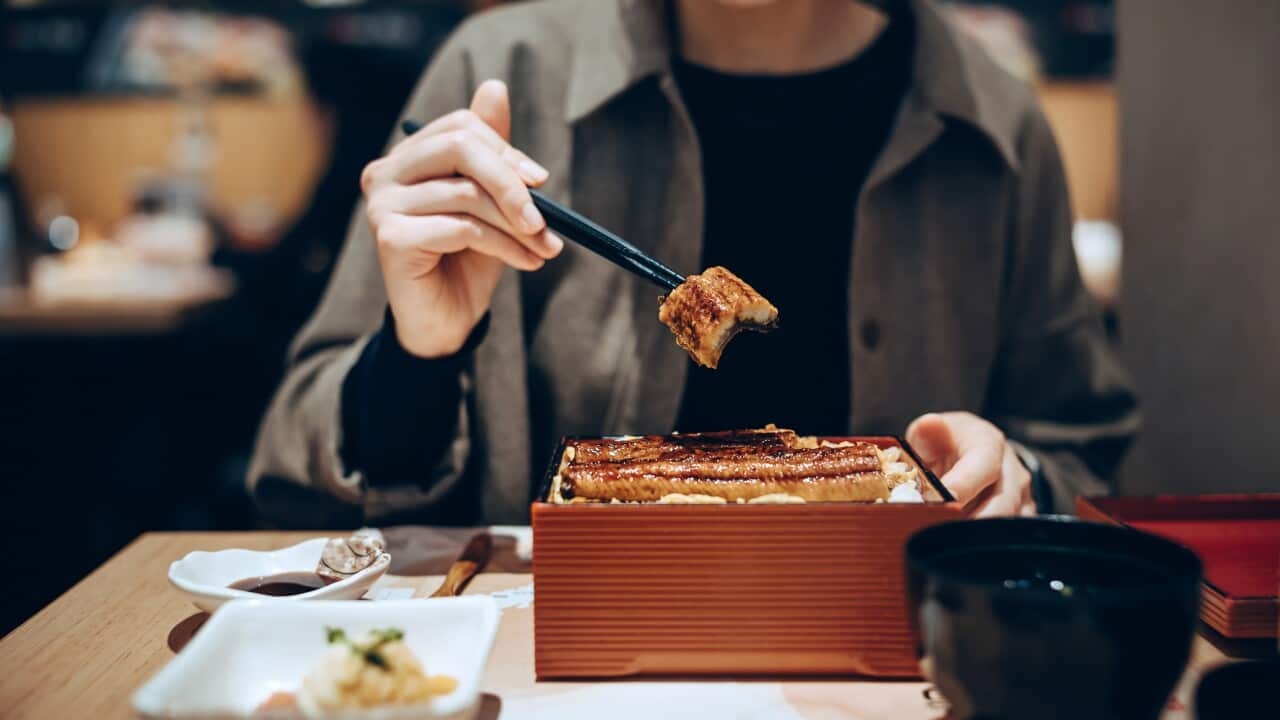Stream free On Demand

Alone Australia
series • action
M
series • action
M
Growing up in the Lettermarriner Clan country in Tasmania’s North Midland Nation, catching eels was a regular part of day to day life for Geoffrey McLean.
“Part of my country is the Cataract Gorge, a place where I still find spiritual solace, and when we were fishing for trout as kids, we also caught eels,” the historian, educator and Tasmanian First Nations man tells SBS Food. “The hardest thing about processing eels is removing their skin. You cut off the head, grip the eel with a hessian sack and use pliers to pull it off.
"My mother hated cooking eels because they’d squirm in the pan like they were alive,” he adds.

Rodney Dunn uses a cold smoking shed to produce smoked eel with a "flavour like bacon". (Food Safari Water) Credit: Food Safari Water
The largest native freshwater fish in Tasmania, eels are abundant in rivers and estuaries. Unsurprisingly, the contestants of the third season of survival series will rely on eels as a main food source, while braving the rugged landscape of Tasmania’s West Coast Ranges this year.
Can you eat eel in Australia?
Of the four species of freshwater eel found in Australia, the short-finned finned eel (Anguilla Australis) is the most common in Tasmania.
Like the Gunditjmara people, Indigenous Tasmanians likely caught eels using woven, conical baskets “made from local materials such as River Reed, Sagg, Blue Flax Lily and White Flag Iris”, McLean and his research partner Dr Louise Zarmati write on their website, . The meat was smoked for preservation purposes.
McLean says due to their abundance, eels are still a sustainable food source, although .
“It’s fine for people to fish for eels as they are extremely abundant and there are no issues with sustainability,” he says. “Not many people actually do, however – anglers often throw them back because eels are incorrectly labelled bottom feeders and it’s assumed they don’t taste nice.”
How to cook with eel
While it may feel like an acquired taste for some, in many cultures, eel is a revered delicacy. In Japan, for example, freshwater eel (unagi) and saltwater eel (anago) are so popular, the Japanese population is responsible for the consumption of 70 percent of eels caught globally, according to .
“Unagi and anago have been part of Japanese cuisine for centuries,” says Shimpei Hatanaka, executive chef of Sake Manly restaurant. Traditionally, eels were skewered whole, seasoned with salt or vinegared miso and grilled. Modern preparations of eel vary across regions.
Try these eel recipes

Unagi no kabayaki (Japanese grilled eel)
“In Western Japan they fillet eel from the belly and season with light soy sauce,” Hatanaka continues. “In Eastern Japan they butterfly the eel from its back, and season with darker soy sauce ideal for barbecuing. Barbeque (kabayaki) is the most common style of preparing unagi today. There’s also hitsumabushi – charcoal-grilled with a sweet soy – or shirayaki – charcoal grilled with salt.”
Depending on the region, anago is fried as tempura, shirayaki, as pressed sushi, or nigiri.
How to eat eel
The flavour and texture profiles of eel vary depending on their country of origin, and whether they’re fresh or salt water.
“I’ve caught unagi in Sydney before,” says Hatanaka. “It was oily and the meat was too firm. The taste was not good. I’ve tried eel from Preston Market in Melbourne also. I cooked it kabayaki style and found it had a strong oily smell.”
Japanese eel is different. “I like unagi a lot,” says Hatanaka. “If it’s wild caught, I prefer to eat it as shirayaki with a bit of freshly-grated wasabi.”
Outside of Asian countries, eel recipes aren't very popular today, but in the 19th century, eel recipes found their way into one of . In 1843, Mrs Irving’s Housewife’s Guide suggested stewing or frying eels.
In many cultures, eel is a revered delicacy.
Eels share a similar nutritional make-up to other fish, rich in vitamins A and B1. “In Japan, we usually eat unagi before doing something that requires a lot of energy,” says Hatanaka. “It’s also rumoured to help men’s sexual health.”
Tasmanian freshwater eel also contains a high levels of omega-3 fatty acids that have been shown to have “beneficial impact on regulating cholesterol, insulin resistance, blood pressures, liver enzymes and inflammatory markers,” according to .
With such a nutritional powerhouse at their disposal, perhaps this season's contestants of need not worry too much about their protein needs being met. Only time will tell!



